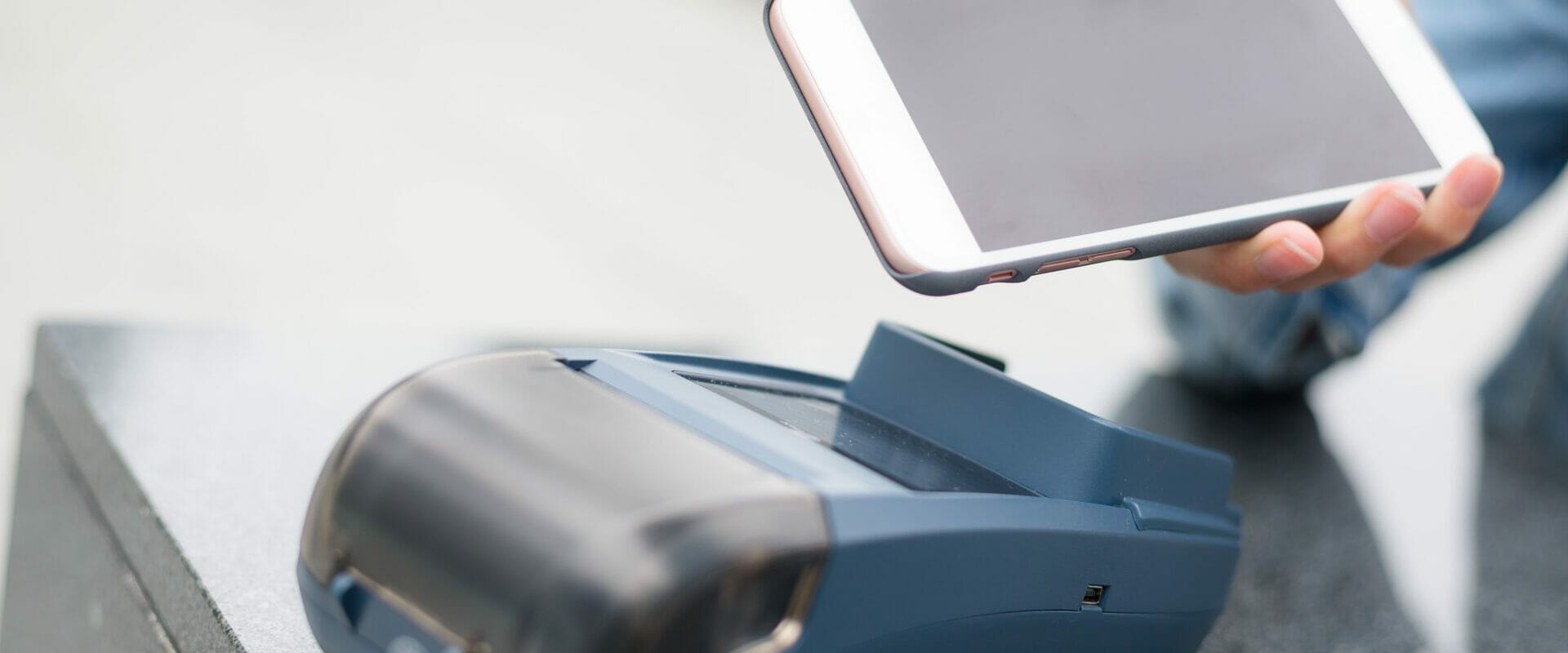Why your business should be transitioning to touchless tech right now
As a business owner in the retail industry, adjusting to the Covid-19 pandemic is a huge challenge. Nevertheless, you’ve crossed your t’s and dotted your i’s.
You’ve worked hard so that customers feel as safe as possible while in your store:
- You require masks at all times.
- You clearly delineate social distancing guidelines with signs and floor decals.
- You separate customers from cashiers with plexiglass at the checkout counter.
You’ve gone to great lengths to ensure the safety of your customers. That is, until they reach the point of sale. For many customers forced to complete their transactions on a touchpad, the worries about contacting and contracting the virus are real. And for good reason.
According to Healthline, public touch surfaces are chalked full of infection causing bacteria. Direct contact with the virus via respiratory droplets is the primary driver of novel coronavirus transmission. Nevertheless, cautions the CDC, the virus may be contracted by touching contaminated surfaces.
So what can you do to put your customers at ease? And how can you ensure that your business thrives during the pandemic? Luckily, the technology not only exists to replace touch surfaces, but is relatively affordable and easy to implement. With minimal effort you can transition many of your operations to touchless technology as part of your broader risk management strategy.
In what follows, we’ll discuss 2 simple ways to make your business, employees and customers safer by adopting handsfree tech.
Let’s begin our discussion by considering touchless payment options.
1. Touchless Payment Options
If you’re like me, the idea of touchless payment technology brings to mind Tony Stark manipulating a holographic interface. It turns out, some of the current touchless technology isn’t so far off from that image. The first of our strategies to transition your retail business to touchless technology is remarkably similar (minus the hologram).
For instance, a number of emerging technologies allow customers to make selections without ever touching a surface. Relying on touchless sensors, these devices detect changes in air pressure allowing customers to make selections based on their proximity to the device’s surface. Thus, there’s no need to touch anything as you head to the checkout line.
While these technologies are attractive, they come with a steep learning curve and are more expensive than traditional payment interfaces. Nevertheless, touchless technology is the future of retail, so rolling out this emerging technology could give you a competitive advantage.
But what if you want to put your customer’s at ease without adopting a potentially cumbersome and costly new payment system? Several more intuitive options exist.
For instance, Radio Frequency Identification or RFID technology, utilizes a small chip to broadcast a unique identifier. As the RFID identifier passes by a receiver, it charges customers for their purchase via a card assigned to the account.

This technology allows customers to complete their purchase without ever touching a keypad. While more efficient than traditional payment methods and more affordable than touchless sensor devices, RFID still requires systemic changes to your business infrastructure.
Finally, near-field communication (NFC), a specialized form of RFID, allows information to be transmitted across devices via radio signals. For example, most smart phones are able to transmit photos across to one another when in close proximity. Similarly, some retailers have begun implementing this technology.
For example, many stores now have applications that allow customers to scan goods as they shop. As they exit the store, a signal is sent to a receiver which then identifies the items scanned and charges the debit or credit card associated with the app.
Touchless payment technology represents the future of retail. And many companies see the pandemic as a great reason to begin using this tech. However, it can be expensive to install this technology.
With that in mind, next we’ll discuss the second approach to transition your retail business to touchless technology.
Let’s check it out.
2. Handsfree Entry/Exit Options
As I left the establishment, I mentally committed to returning in the future, simply because I appreciated their effort to keep me safe and healthy.
Recently, I stopped at a fast food restaurant to use the restroom, and came face to face with a elegantly simple piece of technology: a hands-free door opener. As I approached the door, I spotted a strange metal plate at the bottom. I quickly realized the purpose of this device as I slid the door open with my foot, never touching a handle as I entered the lobby.
This touchless door handle serves as an excellent example of a low-cost solution to a problem created by the pandemic. As I left the establishment, I mentally committed to returning in the future, simply because I appreciated their effort to keep me safe and healthy.
Similarly, but more costly, automatic doors provide a hands-free way to enter and exit buildings.
Finally, consider implementing hands free technology in rest rooms, which are viewed by the public as breeding grounds for harmful microbes. In addition to including touchless door handles on both the main door and stalls, consider installing motion sensitive sinks and paper-towel dispensers.
While we’re on the topic of methods of drying hands, block access to hand dryers, which can increase the amount of airborne microbes.
Both touchless payment and entry/exit methods can help put your customers’ minds at ease, increasing the chances that they’ll visit your store and keep coming back.
Conclusion
Amidst this global pandemic, retailers face a number of challenges. From supply chain disruptions to revenue loss, the obstacles facing this industry over the past 6 months have been and continue to be palpable.
One of the biggest challenges has been getting and keeping customers into stores. For safety reasons people are hesitant to leave their homes to visit brick and mortar stores, instead choosing to shop online or opting for curbside pickup. However, this presents a tremendous opportunity for businesses that are willing to experiment a little. Customers will respond favorably when a company is seen as putting their customers safety first, building greater brand trust and loyalty in the process.
The best way for retailers to address their customers’ safety concerns is to transition to touchless technologies, in addition to social distancing protocols. By retrofitting your stores with touchless payment and entry/exit options, you will not only keep patrons safe, but also take a big step into the future of retail.
But at Chesley Brown, we understand that navigating your business through the global pandemic can be a massive challenge. We’ve built a framework that teaches businesses how to anticipate and navigate risk before it becomes a crisis. We’re here to help.
Posted by:
Sign up!
For industry-leading guides and analysis sign up for our blog below.
Latest News
Podcast | Risk Takers Series #05 Corporate Counterespionage
Its not always the stuff of cold war spy novels but corporate or economic espionage continues to affect businesses all over the world both large and small at an exponential rate. It seems like there’s…
Read Morerisk-takers #04 Brad Orsini – Community-based Security
Visiting our places of worship shouldn’t be dangerous. Unfortunately, faith-based organizations are facing the difficult challenge of how to protect their congregations from religion-motivated violence, and still maintain the welcoming, open environment community members expect.
In this week’s episode Brent calls up Bradley Orsini, the Senior National Security Advisor of the Secure Community Network, the official safety and security organization of the Jewish community in North America to discuss these issues, lessons learned from the mass shooting at the Tree of Life Synagogue, and the most effective strategies faith-based organizations can use to protect their congregations.
Read MorePodcast | Risk Takers Series #04 Brad Orsini – Community-based Security
Visiting our places of worship shouldn’t be dangerous. Unfortunately, faith-based organizations are facing the difficult challenge of how to protect their congregations from religion-motivated violence, and still maintain the welcoming, open environment community members expect.…
Read Morerisk-takers #3 Surveillance Detection Routes (SDR)
Have you ever had a gut feeling you were being followed? You might not be so crazy after all. It’s a frightening thought. You’ve spent years building your business, but all it takes is one bad day to compromise that dream. In this week’s episode Brent sits down with FBI Special Agent (Ret.) Dell Spry to discuss surveillance detection routes, what they are, and how they can be used as a spy detector device to find out if you are under surveillance.
Read MorePodcast | Risk Takers Series #3 Surveillance Detection Routes (SDR)
Have you ever had a gut feeling you were being followed? You might not be so crazy after all. It’s a frightening thought. You’ve spent years building your business, but all it takes is one…
Read More




